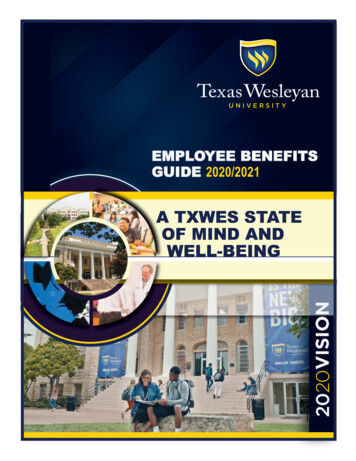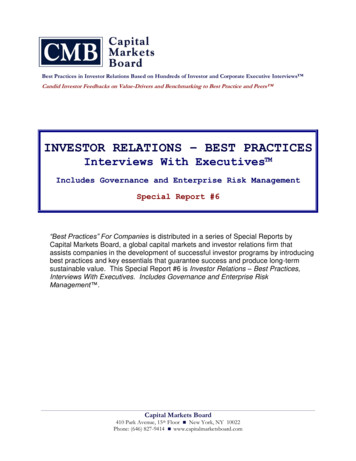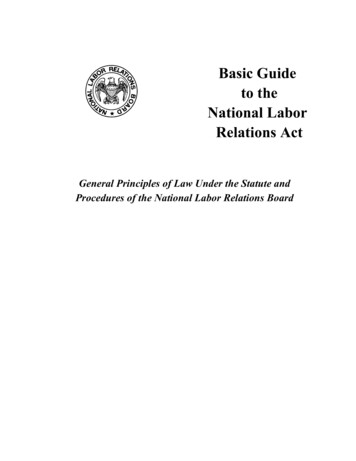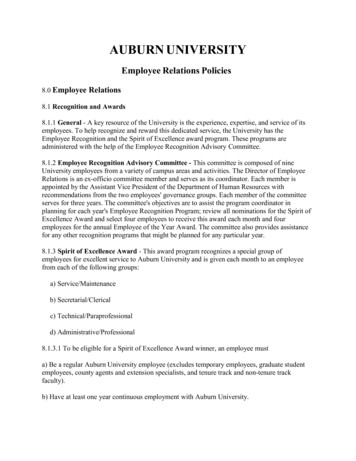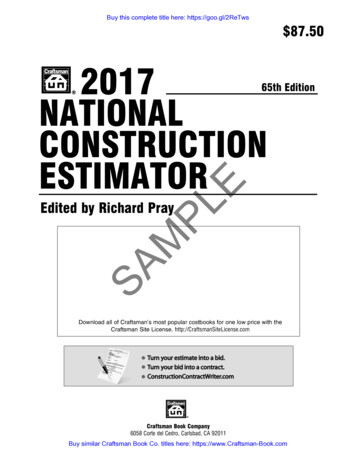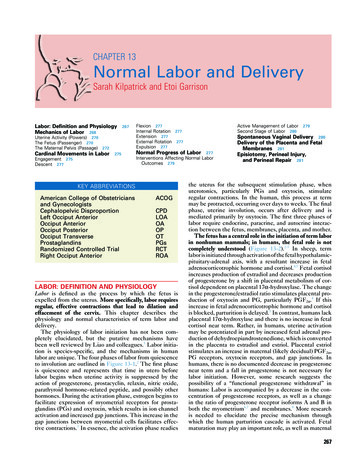
Transcription
Employee & Labor Relations Guide BookTABLE OF CONTENTSPage No.1Forward . . . . . . . . . . . . . . . . . . . . . . . . . . . . . . . . . . . . . . . . . . . . . . . . . . . . . . . . . . . . . . . . 12Performance and Conduct:Introduction/Overview . . . . . . . . . . . . . . . . . . . . . . . . . . . . . . . . . . . . . . . . . . . . . . . . . . . . . 2A.B.C.D.Performance Based Actions (Statutory 5 CFR 432) . . . . . . . . . . . . . . . . . . . . . . . . . . 5Misconduct Based Actions (Statutory 5 CFR 752) . . . . . . . . . . . . . . . . . . . . . . . . . . . . 17Employee Responsibilities and Conduct (Departmental Regulation 4070-735-001) . . 27USDA Guide for Disciplinary Penalties (Department Personnel ManualChapter 751, Appendix A). . . . . . . . . . . . . . . . . . . . . . . . . . . . . . . . . . . . . . . . . . . . . . . . 423 Administrative Grievance Process (15-PM, Part 5): . . . . . . . . . . . . . . . . . . . . . . . . . . . . . 52A. Grievance System for County Employees (Handbook 22-PM). . . . . . . . . . . . . . . . . . . . 774Appeal Procedures (MSPB & EEO). . . . . . . . . . . . . . . . . . . . . . . . . . . . . . . . . . . . . . . . . 805Workplace Violence, Prevention and Response Program. . . . . . . . . . . . . . . . . . . . . . . . 976Labor Relations Information:A.B.C.D.E.Collective Bargaining Agreements (Descriptions) . . . . . . . . . . . . . . . . . . . . . . . . . . . . 101Negotiations . . . . . . . . . . . . . . . . . . . . . . . . . . . . . . . . . . . . . . . . . . . . . . . . . . . . . . . . .104Formal Discussions & Representational Rights . . . . . . . . . . . . . . . . . . . . . . . . . . . . . . .112Weingarten Rights . . . . . . . . . . . . . . . . . . . . . . . . . . . . . . . . . . . . . . . . . . . . . . . . . . . . . 118Union Information Request . . . . . . . . . . . . . . . . . . . . . . . . . . . . . . . . . . . . . . . . . . . . .120U.S. Department of AgricultureEmployee & Labor Relations Guide Book – September 2009i
Employee & Labor Relations Guide Book1 Forward The Employee & Labor Relations Guide Book is meant toassist managers in dealing with those problem situations thatarise in the workplace. Before taking any action, the managershould consult with his or her servicing Employee & LaborRelations Specialist.U. S. Department of AgricultureEmployee & Labor Relations Guide Book – September 20091
Employee & Labor Relations Guide Book2 Performance and Conduct:Introduction/Overview:Correcting Employees’ Performance and ConductWhat is the purpose of discipline? Why do I have to carry it out?These are questions every supervisor has asked at one time or another, andthey have clear and businesslike answers.In an environment where all workers were highly motivated, trustworthy, capable, congenialand selfless, disciplinary action would perhaps be unnecessary. However, it’s an imperfectworld. Though most employees conform to rules and regulations and give a full day’s workfor their pay of their own accord, there still remain those few who do not, cannot or will not.This small fraction of employees requires closer supervision and, sometimes, correctivemeasures to ensure they do not stray over the boundary into unacceptable conduct.Corrective action is noted by all, not just those immediately concerned. Actions taken fairly,rapidly and correctly serve as examples to others who might be tempted to test theboundaries of acceptable behavior. Such actions reinforce the good habits of those who arenot conduct problems. The reputation and integrity of the Federal service as a whole dependson public trust, on the taxpayers' perception that Government workers do conform tobusinesslike rules and are accountable for their performance and conduct. If this trust isbetrayed, if taxpayers lose confidence in the integrity and ability of Federal workers, theGovernment will cease to function.This is why discipline is sometimes necessary. And, in order to avoid the perception thatsuch discipline is merely imposed from above, it must come from the concerned supervisorwho knows the problems and has the best chance of correcting them at the lowest level. It isa difficult job, which only those most concerned are properly equipped to do. It is theexercise of disciplinary authority over other employees which distinguishes supervisoryresponsibility from the lesser responsibilities connected with just getting the job done.U. S. Department of AgricultureEmployee & Labor Relations Guide Book – September 20092
Employee & Labor Relations Guide Book2 Performance and Conduct (Continued):Introduction/Overview (Continued):Actions Based on Unacceptable PerformanceWhen performance problems are identified, counseling regarding thedeficiencies should begin with the goal of aiding the employee to bringperformance back up to an acceptable level. Before effective counseling canbegin, you have to analyze the performance problem. In other words, youmust determine if it is a "can't do" or a "won't do" situation. Can’t doIf the employee lacks the skill or specific knowledge required or is no longer able to dothe job, you have a "can't do" problem and need to determine the following: Did the employee do the job in the past? Does the employee have the potential to perform at a fully successful level? Has the employee forgotten how to do certain tasks? How often is the skill or knowledge used?Possible alternatives in "can't do" situations include providing the employee with writteninstructions, assigning an on-the-job coach, providing additional formal training,restructuring the job temporarily or increasing supervision. If the situation results fromphysical or other limitations, reassignment to a different type of work may resolve theproblem. In some instances, you may want to make the employee aware of the EmployeeAssistance Program. If the situation is the result of an employee's selection for a positionbeyond his or her ability, reassignment may be an alternative. Won’t doIf the employee has attitude problems, lacks motivation, or has external obstacles toperforming, you may have a “won’t do” situation and should consider the following: Does the employee find nonperformance rewarding because more attention isreceived for negative behavior than for positive behavior? Does the employee seem unconcerned about performing acceptably? Does the employee lack motivation because the job is repetitive and no longerchallenging?U. S. Department of AgricultureEmployee & Labor Relations Guide Book – September 20093
Employee & Labor Relations Guide Book2 Performance and Conduct (Continued):Introduction/Overview (Continued):The solutions to "won't do" problems are often more complex and difficult. If the failure toperform is willful or intentional, a disciplinary action may be more appropriate than aperformance-based action. If a personality conflict exists, reassignment may be analternative. If the problem is a general distrust of authority figures, reassignment would notsolve the real problem.Motivational problems may be solved by changing a work assignment or by restructuring theway the work is accomplished. If the employee is having personal problems, advise theemployee of the Employee Assistance Program. While you are expected to considercorrective solutions such as those listed, you are not expected to tolerate "won't do"situations that result in gross negligence, insubordination, or morale problems.Dealing With Unacceptable PerformanceThe reasons for unacceptable performance are as varied as the number of employees withperformance problems. Each case must be analyzed to determine the best approach to assist thatemployee to perform acceptably. Communicating with the employee is most important.Discussion of the performance deficiencies must be timely and rational, with clear directiongiven by you and assurance that the expectations are understood by the employee.Your day-to-day efforts to help the employee improve performance deficiencies should be notedas well as the employee's failure to perform acceptably, if that is the case. Those significantpatterns or indications of unacceptable performance must be shared with the employee. Thesesignificant patterns include relevant samples of an employee's work which are indicative of theemployee's poor performance.The objective when dealing with a case of unacceptable performance continues to be to assistand encourage the employee to improve to an acceptable level so that the mission of the servicecan be accomplished. However, if day-to-day efforts do not correct the unacceptableperformance within a reasonable period of time, a formal counseling session establishing aformal opportunity to improve should be given.Removals and Reductions-In-Grade For Unacceptable PerformanceIf after taking steps to deal with an employee with performance problems (counseling, closesupervision, training if needed, etc.), the employee continues to produce unacceptable work in atleast one critical element of the job, it may be appropriate to take a formal action based onunacceptable performance under Part 432 of 5 CFR. An employee may be reduced in grade orremoved at any time during the performance appraisal cycle if the performance in any one ormore critical elements of the job becomes unacceptable, but only after having been given anopportunity to improve.U. S. Department of AgricultureEmployee & Labor Relations Guide Book – September 20094
Employee & Labor Relations Guide Book2 Performance and Conduct (Continued):A. Performance Based Actions (Statutory 5 CFR 432) 1/Consult Your Human Resources Office Before Beginning This FormalProcedureEstablishing an opportunity period requires a formal counseling sessiondocumented in an "Opportunity To Improve (OTI)." The length of theopportunity period depends on the employee's job; the period can varybut should not be less than 90 days. This process requires specificdocumentation of the unacceptable performance.The overall development of a performance-based action is of primary importance in preparingthe action. The preparation should begin with an assurance that the employee with theperformance problem is fully aware of what is required. While this requirement may legally bemet with the receipt by the employee of the critical elements/performance standards,expectations concerning specific assignments should also be documented. For example, if theproblem concerns timeliness, counseling documentation should clearly show that the employeewas fully aware of what the time expectations were. A case is stronger when it can be shownthat the employee was given specific directions as to what was expected on a specificassignment.Management decides what is expected on a specific assignment and management decides what isimportant in an assignment. Your records should clearly show how management directed anassignment to be completed. Otherwise, managers may be second-guessed by third parties as towhat should have been done on an assignment.After it has been shown that the employee was fully aware of the expectations, it must be shownthat there is a repetition or pattern of failure to such a degree that an element was not beingperformed successfully. A performance deficiency may represent unacceptable performance inmore than one critical element. In such a case it would be best to zero in on the critical elementthat best exemplifies the relationship of failure to the accomplishment of the job.Formal Counseling and Opportunity to Improve LetterThe formal counseling session is very important in that it serves as thefoundation for all future action. Therefore, thorough preparation isvital. Employee/Labor Relations Specialists should be involved in yourpreparations.1/ 5 CFR 432 applies only to Federal employees. However, the basic principles in handlingperformance-related issues are applicable to county office employees, although final appealprocedures under 5 CFR 432 do not apply.U. S. Department of AgricultureEmployee & Labor Relations Guide Book – September 20095
Employee & Labor Relations Guide Book2 Performance and Conduct (Continued):A. Performance Based Actions (Statutory 5 CFR 432)(Continued)During the counseling session, or shortly thereafter, a letter must be given to theemployee to establish the formal opportunity period to improve to the fullysuccessful level. The letter must contain the following: The critical element(s) and performance standard(s) in which the employee’sperformance is unacceptable and the exact nature of the deficiencies. Examples ofunacceptable performance must be included. The improvements expected. Provide practical advice on how the employee can meet thecritical elements, such as references to use and improved work habits. The fact that failure to become acceptable in one or more critical elements may result in aproposal to separate the employee from the position or agency. The specific period of time in which the employee will be given the opportunity todemonstrate acceptable performance. Consideration should be given to complexity ofduties, length of experience in position, prior performance record and training. The fact that you are committed to work with the employee. List what efforts you willmake to help the employee. (You must follow through on commitments made.)Other elements that may be included in the OTI letter are: reference toprevious counseling sessions, past efforts made to assist the employee toimprove, your availability to answer the employee's questions,reassurance that the employee is not marked for failure and commitmentto a real opportunity for improvement.Even though the process is now formalized, the objective is still to assistand encourage the employee to improve to an acceptable level so that themission of the Agency can be accomplished.U. S. Department of AgricultureEmployee & Labor Relations Guide Book – September 20096
Employee & Labor Relations Guide Book2 Performance and Conduct (Continued):A. Performance Based Actions (Statutory 5 CFR 432)(Continued)Sample Opportunity to Improve (OTI) LetterU. S. Department of AgricultureEmployee & Labor Relations Guide Book – September 20097
Employee & Labor Relations Guide Book2 Performance and Conduct (Continued):A. Performance Based Actions (Statutory 5 CFR 432)(Continued)Sample Opportunity to Improve (OTI) LetterOrForm AD-435D, Opportunity to Improve (see next page)U. S. Department of AgricultureEmployee & Labor Relations Guide Book – September 20098
Employee & Labor Relations Guide Book2 Performance and Conduct (Continued):A. Performance Based Actions (Statutory 5 CFR 432)(Continued)Form AD-435D, Opportunity to Improve, Page 1U. S. Department of AgricultureEmployee & Labor Relations Guide Book – September 20099
Employee & Labor Relations Guide Book2 Performance and Conduct (Continued):A. Performance Based Actions (Statutory 5 CFR 432)(Continued)Form AD-435D, Opportunity to Improve, Page 2U. S. Department of AgricultureEmployee & Labor Relations Guide Book – September 200910
Employee & Labor Relations Guide Book2 Performance and Conduct (Continued):A. Performance Based Actions (Statutory 5 CFR 432)(Continued)Form AD-435D, Opportunity to Improve, Page 3U. S. Department of AgricultureEmployee & Labor Relations Guide Book – September 200911
Employee & Labor Relations Guide Book2 Performance and Conduct (Continued):A. Performance Based Actions (Statutory 5 CFR 432)(Continued)Sample Letter Informing Employee of Improved PerformanceU. S. Department of AgricultureEmployee & Labor Relations Guide Book – September 200912
Employee & Labor Relations Guide Book2 Performance and Conduct (Continued):A. Performance Based Actions (Statutory 5 CFR 432)(Continued)Considerations at the End of the Opportunity to Improve PeriodAt the end of the specified period a determination must be made as to whether sufficientimprovement has been made and, if not, what the course of action will be. Consequently, carefuldocumentation of performance during this period is very important. In effect, the OTI becomes ashortened evaluation period. It is the performance in the cited unacceptable critical element(s)that will be evaluated in making a determination as to the course of action at the end of the OTI.If an employee's overall performance in the cited unacceptable critical element(s) becomesresults achieved during the OTI, the employee will be so notified in writing.If an employee's performance once again deteriorates (within one year of the OTI being issued)the OTI action may be taken to reassign, remove or demote the employee without providinghim/her with an additional opportunity.If at the end of the opportunity period, it is determined that the employee's performance hasimproved but still is less than results achieved, consideration may be given to extending theopportunity period. If so, a notice should be given to the employee which acknowledges theimprovement, identifies what is needed to become results achieved, and specifies the period oftime for which the opportunity has been extended.Proposing a Removal or Reduction-In-Grade For Unacceptable PerformanceIf an employee's performance remains unacceptable during the OTI, a determination must bemade as to whether a proposed reduction-in-grade or removal is appropriate. You are notprecluded from considering alternatives such as reassignment to another position, voluntaryreduction-in-grade or voluntary retirement. The manager's recommendation for appropriateaction is requested by memorandum to the Employee/Labor Relations Branch/Section throughchannels. All proposals and decision letters are written by the Employee and Labor RelationsSpecialist.The requirements for a proposed reduction-in-grade or removal are set forth in law. As notedpreviously, complete documentation of the unacceptable performance is essential in preparing aperformance-based action.In proposing a removal or reduction-in-grade for unacceptable performance, the notice mustinclude the critical element(s) and performance standard(s) that are unacceptable. The instancesof unacceptable performance cited must have occurred in the rating period for which theproposal letter is issued. It is essential that instances of unacceptable performance whichoccurred during the OTI be included.U. S. Department of AgricultureEmployee & Labor Relations Guide Book – September 200913
Employee & Labor Relations Guide Book2 Performance and Conduct (Continued):A. Performance Based Actions (Statutory 5 CFR 432)(Continued)In the proposal, the employee is given a 30-day advance notice period during which theemployee has a reasonable time in which to answer orally or in writing. A reasonable period oftime is considered 15 days from receipt of the proposed action letter. An employee may requestan extension of time within this period to submit an oral or written reply.The decision on the proposed action MUST be issued to the employee within 30 days afterexpiration of the advance-notice period. This time limit is stated in 5 U.S.C. 4303(c)(1) andmust be complied with.County EmployeesThe procedures for taking a performance-based action for county employees are contained inNational Handbook 22-PM. A county employee will receive a letter advising him or her of theremoval or downgrade and the reasons for the action. The letter will state what appeal rights thecounty employee has. The effective date of the action must be set 14 days after the employeereceives the letter. With the approval of Deputy Administrator for Field Operations (DAFO),administrative leave may be granted for this 14-day period if the employee’s presence in theoffice may affect efficient operations.Denial of a Within-Grade IncreaseIf an employee's within-grade increase is coming due and the employee is not performing at anacceptable level of competence - that is, at a fully successful level - certain procedures must befollowed to deny the step increase. Counseling regarding the unacceptable or marginalperformance should have been ongoing.U. S. Department of AgricultureEmployee & Labor Relations Guide Book – September 200914
Employee & Labor Relations Guide Book2 Performance and Conduct (Continued):A. Performance Based Actions (Statutory 5 CFR 432)(Continued)Notice of Denial of a Within-Grade IncreaseA decision to deny a within-grade increase should be communicated to the employee prior to theeffective date of the within-grade increase. The written notice should include: A statement informing the employee of the reason(s) for the denial – with reference tospecific critical element(s) and performance standard(s) – and that the within-grade isbeing denied. A statement that, if performance improves to a fully successful level, the within-gradewill be granted effective the first day of the pay period following its approval andcertification. A statement that the employee may make a written request for reconsideration and that itis due within 15 calendar days from the date of receipt of the denial letter. A statement that the employee has the right to contest the negative determination, bothpersonally and in writing, as well as the right to be represented by an attorney or otherrepresentative.U. S. Department of AgricultureEmployee & Labor Relations Guide Book – September 200915
Employee & Labor Relations Guide Book2 Performance and Conduct (Continued):A. Performance Based Actions (Statutory 5 CFR 432)(Continued)ReconsiderationAn employee may request reconsideration of a within-grade denial byfiling such a request in writing within 15 calendar days of receipt ofthe denial.A final decision, to grant or deny the within-grade increase must bemade promptly and in writing.If the reconsideration is favorable to the employee, the within-grade isgranted retroactively. If the reconsideration affirms the denial, thewritten decision should include the reasons for the decision and theemployee's right of appeal.Employees may appeal to the Merit Systems Protection Board the denial of their within-gradeincrease.Procedural requirements for actions based on unacceptable performance must be followed toensure that the action is ultimately successful and at the same time all the legal rights guaranteedto the employee are protected. While the procedural requirements are complex, you are notexpected to become an expert in all of them. Your Employee and Labor Relations Specialist willprovide the expert advice and assistance that you will need.NOTE: County employees do not have reconsideration rights or appeal rights toMSPB on performance or conduct-based actions.U. S. Department of AgricultureEmployee & Labor Relations Guide Book – September 200916
Employee & Labor Relations Guide Book2 Performance and Conduct (Continued):B. Misconduct Based Actions (Statutory 5 CFR 752)Conduct and DisciplineDiscipline is necessary for the orderly and efficient administration ofthe Agency and accomplishment of the Agency's mission.Discipline is achieved by the promulgation of rules and enforcement of those rules byappropriate disciplinary or nondisciplinary actions.The purpose of discipline is to correct: not punishThe appropriate disciplinary action is the least severe action which will correct the misconduct.Generally, the more serious the misconduct, the more severe the disciplinary action. Consistencyin taking disciplinary action is a primary objective. Disparate treatment (treating similarlysituated employees differently) may indicate an improper action and may be grounds for a thirdparty to reverse a disciplinary action. However, mitigating and aggravating factors must also beconsidered.ResponsibilitySupervisors are responsible for making employees aware of workand office requirements and for maintaining discipline within thespan of their authority. When violations occur, supervisors must: Document the occurrence Refer the matter to the Office of Inspector General (OIG)when appropriateRecommend or take appropriate action depending on the authority they’ve beendelegated.The Employee/Labor Relations Branch/Section is responsible for advising and assistingsupervisors in their efforts to maintain discipline and for ensuring that actions taken are inaccordance with the law and regulations.Employees are responsible for compliance with the various work requirements issued to them,including the Rules of Conduct. In addition, they are responsible for reporting misconduct eitherto OIG (criminal conduct and violations of the rules of conduct) or to their supervisors.U. S. Department of AgricultureEmployee & Labor Relations Guide Book – September 200917
Employee & Labor Relations Guide Book2 Performance and Conduct (Continued):B. Misconduct Based Actions (Statutory 5 CFR 752) 1/(Continued)Types of MisconductHow disciplinary cases develop depends on the type of misconduct. The twobasic types of misconduct are:1. Criminal Acts – Report of such misconduct must be made directly to OIG. OIG maythen investigate, interview the employee, and produce a report of investigation which willbe forwarded to management for a determination as to what, if any, disciplinary actionmight be appropriate. OIG may be asked to do additional investigating if moreinformation is needed in order to properly adjudicate the case. As a general rule, reportsof investigation are referred to first level managers for an initial recommendation.2. Administrative Disciplinary Matter – Managers are generally able to deal withadministrative matters without the assistance of professional investigators. However,sometimes management may request that the Employee/Labor Relations Branch/Sectionconduct an administrative misconduct investigation. Typical administrative mattersinclude such things as: Tardiness, AWOL, or leave abuseUse of intoxicants or being intoxicated on dutyInsubordinationFightingIndebtednessTaking Appropriate ActionBefore proposing or taking any action, one must determine whether the available evidence thatcan be provided to the employee can support any of the following actions:1. An adverse action (removal, demotion, or suspension of more than 14calendar days) must be supported by a “preponderance of the evidence,”which is evidence that a reasonable person would accept as sufficient to finda contested fact more probably true than untrue.2. A disciplinary action (1 to 14 day suspension, reprimand) must also besupported by preponderance of the evidence.1/ 5 CFR 752 applies only to Federal employees. However, the basic principles on handlingmisconduct based actions are applicable to county office employees, although appealprocedures do not apply.U. S. Department of AgricultureEmployee & Labor Relations Guide Book – September 200918
Employee & Labor Relations Guide Book2 Performance and Conduct (Continued):B. Misconduct Based Actions (Statutory 5 CFR 752)(Continued)Types of Action1. A clearance letter is appropriate if the evidence establishes theinnocence of the employee or clearly fails to support theallegation.2. A closed without action letter or cautionary letter isappropriate if the evidence is inconclusive, or if it is determinedthat a disciplinary action is not warranted, but the employeeshould be cautioned about certain conduct.3.A letter of reprimand is the least severe form of disciplinary action. It is appropriatefor the first offense, or, in line with the concept of progressive discipline, for repetition ofa relatively minor offense. The action should make it clear that failure to correct themisconduct could result in more serious action, up toand including removal from the service. A copy ofthe reprimand is filed in the employee’s OfficialPersonnel Folder for a period of 2 years.U. S. Department of AgricultureEmployee & Labor Relations Guide Book – September 200919
Employee & Labor Relations Guide Book2 Performance and Conduct (Continued):B. Misconduct Based Actions (Statutory 5 CFR 752)(Continued)4. A suspension is the involuntary placement of an employee who is otherwise ready,willing and able to work in a non-duty, non-pay status. It is used to correct serious orrepeated misconduct. It is an appropriate disciplinary measure when less severe actionsfail to correct an employee’s conduct or when the gravity of the offense warrantsstringent corrective action. A suspension of more than 14 days (which is classified as anadverse action and can be appealed to the Merit System Protection Board) is rarely takenexcept for offenses with a minimum 30-day suspension, such as Hatch Act violations ormisuse of a government vehicle.5. A reduction-in-grade or pay (demotion) is used as a disciplinary action only in unusualsituations. One example is to change a manager to a lower grade non-supervisoryposition when the employee’s misconduct would damage or impair his or hereffectiveness as a manager.6. A removal is taken when employee conduct is sufficiently serious to warrant terminationof the employment relationship; in other words, when it is not possible to “correct” themisconduct by disciplinary action. Some examples are serious violations of criminalstatutes, corruption, substantive conflict of interest, material breach of integrity, physicalassault or acts which cause or threaten to cause serious damage to the service and itspublic image, or repeated incidents of relatively minor misconduct which progressivediscipline has failed to correct.7. Occasionally, when an employee is involved in criminal conduct and the agency eitherdoes not have enough evidence to take a removal action, an indefinite suspension can beeffected as a temporary measure. This action can be taken when it is established thatthere is “reasonable cause to believe a crime has been committed,” such as from anindictment or preliminary investigation.U. S. Department of AgricultureEmployee & Labor Relations Guide Book – September 200920
Employee & Labor Relations Guide Book2 Performance and Conduct (Continued):B. Misconduct Based Actions (Statutory 5 CFR 752)(Continued)Factors to Consid
Employee & Labor Relations Guide Book U. S. Department of Agriculture Employee & Labor Relations Guide Book - September 2009 4 2 Performance and Conduct (Continued): Introduction/Overview (Continued): The solutions to "won't do" problems are often more complex and difficult.



